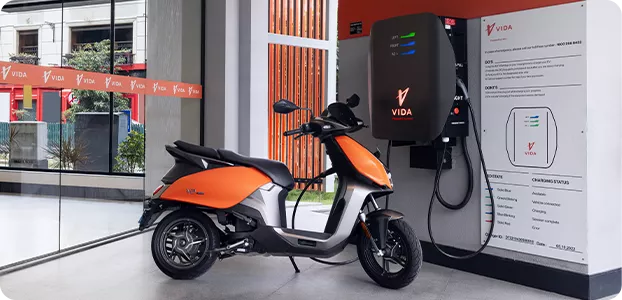Discover VIDA’s EV charging infrastructure strategy in India. Learn about home charging, public stations & detachable batteries. See how it shapes EV adoption.
When I first considered switching to an electric scooter, my biggest hesitation wasn’t the price or even the performance – it was the charging question. “Where will I charge it?” became my mental roadblock. Two years and one electric scooter later, I’ve developed a keen interest in how EV manufacturers approach this challenge of EV charging networks in India, particularly Hero VIDA, whose strategy of VIDA charging stations reveals some interesting insights about the future of electric mobility in India.
The Three-Pronged Approach
VIDA seems to understand that Indian EV users have vastly different living situations and commuting patterns. Their charging strategy reflects this reality with a three-way solution that I find quite pragmatic.
When it comes to scooter charging in VIDA, the portable charger that comes with VIDA scooters is the first line of defense against range anxiety. It’s nothing fancy; simply plug it into a standard 15A socket at home for a reliable overnight charging solution. For someone like me who parks in an apartment complex, this basic solution handles about 90% of my charging needs.
What’s more interesting is their public charging network strategy. Unlike some competitors who’ve gone all-in on building proprietary networks, VIDA seems to be taking a more collaborative approach. The VIDA app lets you locate and even book slots at compatible charging stations along with VIDA charging stations. This partnership model might be less flashy than building branded charging stations everywhere, but it’s potentially more scalable.
The third element – wall-mounted home charging units – targets users who want faster charging at home. While installation assistance is provided, I wish there was more transparency about installation costs and specifications. That’s an area where Ola and Ather currently provide clearer information.
The Detachable Battery Advantage
One feature that stands out in VIDA’s infrastructure strategy is the detachable battery option available in their models. This is particularly clever for the Indian context and the limited EV charging networks in India.
My friend who lives in an old Delhi apartment building has no way to run a charging cable to his scooter parked on the street. For him, the ability to bring the battery upstairs to charge is not just convenient – it’s the only way an EV works in his situation. VIDA’s modular battery approach in their newer models, like the VX2 Plus, with its dual 3.4 kWh battery setup, addresses this need directly.
The App-Centric Experience
The VIDA approach appears to be heavily app-dependent, which is both beneficial and challenging. Finding VIDA charging stations, monitoring charging status, and even booking slots happen through their app. This works wonderfully when you’re in areas with good connectivity, but I wonder about the backup options in areas with spotty networks or for less tech-savvy users.
Compared to Ather, which prominently displays its charging network on its website with clear information about speeds and pricing, VIDA could be more transparent about these details outside the app ecosystem.
The Road Ahead
As an EV enthusiast watching this space closely, I believe the VIDA infrastructure strategy reveals a thoughtful approach to addressing the complexity of the Indian market. Rather than pursuing flashy headlines about thousands of charging points, they seem focused on solving the actual charging challenges that different user segments face.
Their mix of home charging solutions, particularly the detachable battery option, combined with a collaborative approach to public scooter charging like VIDA, suggests a company thinking beyond just selling scooters to creating a viable ecosystem for electric mobility.
For potential EV adopters still on the fence when it comes to EV charging networks in India, this multifaceted approach to charging might just be the reassurance needed to make the switch. After all, it’s not just about how good the scooter is – it’s about how seamlessly it fits into your life.









